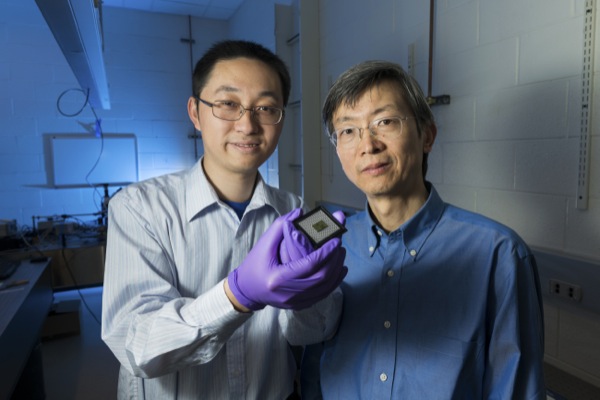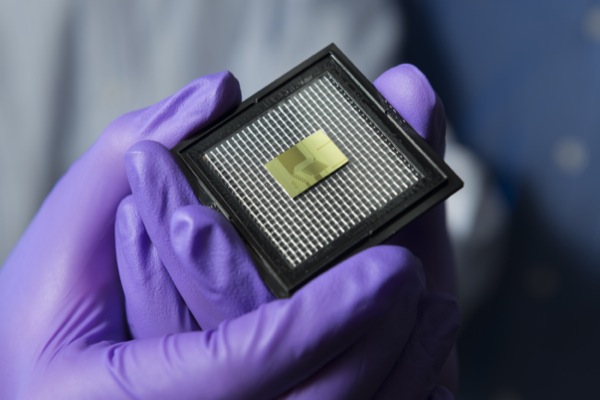Sensor on a chip
New technology holds potential for monitoring ecosystem, human health
11:04 a.m., May 23, 2013--University of Delaware researchers are developing sensors that they hope will allow real-time, in situ detection of water and air pollutants in an inexpensive and environmentally friendly manner.
Juejun Hu and Chaoying Ni of UD’s Department of Materials Science and Engineering are creating small, highly sensitive devices that will detect organic, inorganic and biological molecular species at low levels in the environment. The team is funded by a seed grant from the National Science Foundation’s Delaware Experimental Program to Stimulate Competitive Research (EPSCoR).
Research Stories
Chronic wounds
Prof. Heck's legacy
“We’re making nanostructures to detect chemical molecules in a very sensitive manner,” said Hu, an assistant professor who is the lead researcher on the project.
With further research and development, the devices could be integrated into portable, battery-powered sensor packages, replacing more traditional molecular detectors, which require bulky and expensive equipment.
Deployed in a network in the field, an array of the small sensors could detect contamination in air, water and soil in real time and relay that information wirelessly to a computer.
A major obstacle preventing small sensors from becoming practical replacements for bulky machines is that the new technology is still less sensitive and specific in its detection than the instruments currently in use. The project aims to create sensors that overcome these obstacles.
“It’s a new type of sensor,” said Ni, associate professor. “It is very small and, more importantly, it is very sensitive and very specific.”
The researchers use a focused ion beam (FIB) to punch holes into a thin strip of chalcogenide glass (ChG) a few micrometers thick, or about one-tenth the width of a hair. When light passes through the strip, molecules in the environment selectively absorb one or a few particular colors of the light. The unique optical absorption signals can then be used to identify the presence and concentration of the molecules of interest. The researchers plan to group several of the tiny, chip-sized devices together to create a sensor capable of detecting multiple types of molecules.
“In the end, the device will be very sensitive compared to current technology. We expect around two to four orders of magnitude improvement,” said Hu. “It will also be small and leave a very small footprint. Once integrated, it will be the size of a hockey puck and can be placed discreetly in the environment.”
Since the researchers began the project about a year ago, they have successfully created several chips, although they have encountered some problems along the way.
“Fabricating the device was difficult,” said Ni. “The holes have to be punched with great precision. That’s why we need the focused ion beam, which turned out to be perfect for this project.”
Although the project is still in its early stages, with testing only having started this past fall, Hu is already looking ahead to the practical benefits the devices could have for the environment.
"We’ll be able to continuously monitor environmental pollutants, so we’ll know if water in a stream is getting polluted or if a chemical plant is leaking. We can also use it to detect toxic leaks in industrial plants,” he said.
Hu added that once the technology is sensitive enough, chip-scale sensors could be useful in other fields, including biomedicine.
“We could use the devices to check for certain diseases by analyzing a patient’s breath,” he said. “The sensor would be able to detect trace molecules in the air they exhale.”
Ni agreed that the devices could have a significant impact. “They could be a game-changing type of thing,” he said.
Article by Juan Guerrero
Photos by Evan Krape












